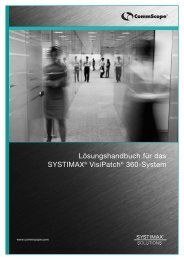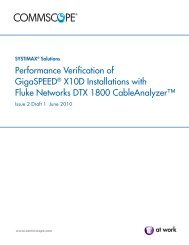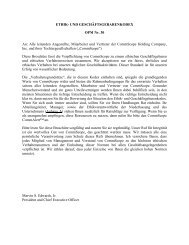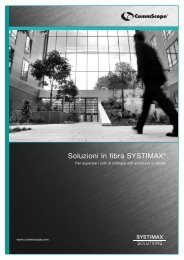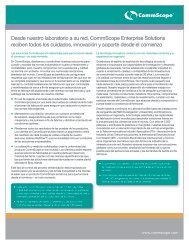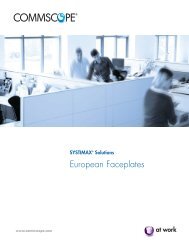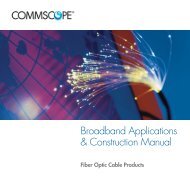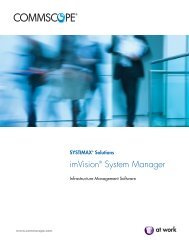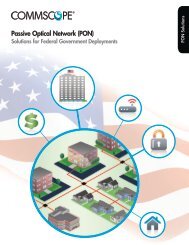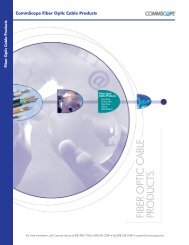Enterprise Design Guide - Public - CommScope
Enterprise Design Guide - Public - CommScope
Enterprise Design Guide - Public - CommScope
You also want an ePaper? Increase the reach of your titles
YUMPU automatically turns print PDFs into web optimized ePapers that Google loves.
Network Cable Performance Criteria<br />
Two critical factors in measuring data cable performance are insertion loss (also called<br />
attenuation) and bandwidth.<br />
Insertion loss is the loss of power as a signal travels along a cable and controls its operating<br />
distance; insertion loss is expressed in decibels (dB) per a unit of distance. Lower numbers are<br />
better.<br />
Bandwidth is the information-carrying capacity of a cable; it’s expressed in MHz for twisted<br />
pair and MHz•km for fiber. Higher numbers are better.<br />
Broadly stated, the strength of a signal decreases over distance. Other factors, such as poor<br />
connections or splices, or even bends and kinks in cables, can also lead to loss of signal.<br />
TIA/EIA 568 standards state the maximum operating distance as 90 meters (295 feet) for<br />
horizontal links (using either fiber or twisted pair) and 300 meters (984 feet) between horizontal<br />
and intermediate crossconnects using multimode fiber links.<br />
Network speeds increase constantly. A few years ago, a typical system would have a 100<br />
Mb/s backbone connecting 10 Mb/s horizontal subsystems. 10 gigabit backbones now<br />
support 1 Gb/s to the desktop, while 100 Gb/s backbones with 10 Gb/s to the desktop are<br />
on the horizon.<br />
The chart below shows where twisted pair and fiber cables fit into the matrix of network<br />
speed and distance. Category 6A twisted pair supports 10 Gb/s systems within TIA/EIA<br />
recommendations for horizontal channels up to 100 meters (328 feet), while Category 6 and<br />
5e twisted pair supports 1 Gb/s desktop connections.<br />
In the past, the TIA/EIA operating standard mentioned only 62.5 µm fiber; the standard now<br />
supports higher bandwidth 50 µm fibers permitting faster network traffic over longer distances<br />
(see pages 27 through 29 for comparisons), and 50 µm laser-optimized fiber has become the<br />
standard multimode fiber chosen for new builds.<br />
10 Gb/s<br />
1 Gb/s<br />
100 Mb/s<br />
10 Mb/s<br />
1 Mb/s<br />
10 Gb/s<br />
1 Gb/s<br />
100 Mb/s<br />
10 Mb/s<br />
1 Mb/s<br />
campus operating range<br />
collapsed backbone operating range<br />
horizontal operating range<br />
all fibers measured at 850 m<br />
100m 300m 500m 1000m 2000m<br />
50m<br />
150m<br />
OM4<br />
50 µm fiber<br />
OM3<br />
50 µm fiber<br />
OM2+<br />
50 µm fiber<br />
OM1<br />
62.5 µm fiber<br />
Category 6A<br />
twisted pair<br />
Category 5e/6<br />
twisted pair<br />
OM4<br />
50 µm fiber<br />
OM3<br />
50 µm fiber<br />
OM2+<br />
50 µm fiber<br />
OM1<br />
62.5 µm fiber<br />
Cat 6a<br />
twisted www.commscope.com pair<br />
23<br />
Cat 5e & 6<br />
twisted pair



